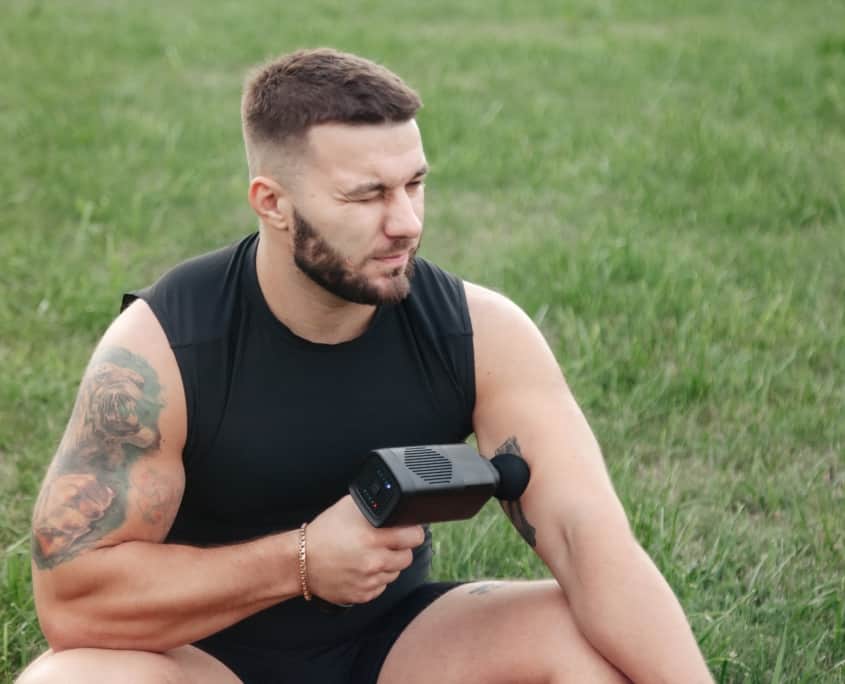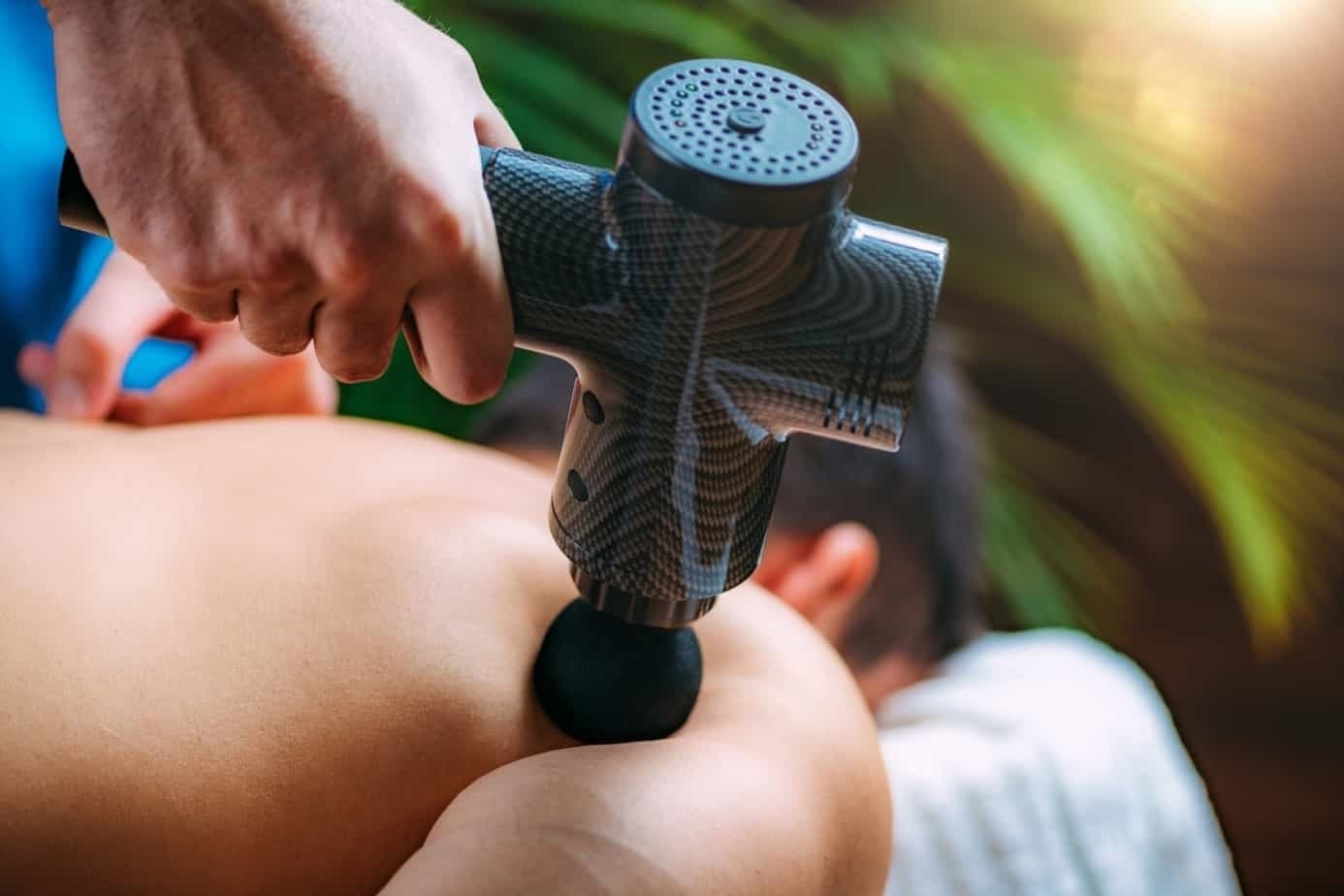Do massage guns really do what they claim to do?
Recovery is important for every athlete, and massage can play a part. But do massage guns actually fast-track recovery?
You see the advertisements everywhere but what actually is a massage gun?
If you’re active on social media, you’ll have seen the adverts. Perhaps one of your favourite athletes sitting, having finished training, with what looks like a robotic hammer pulsing (often in slow motion) into their thighs, calves, or other relevant muscles. The manufacturers of these pieces of equipment are on a real marketing push at the moment to infiltrate our consciousnesses. But what are they, what do they do, and should we be buying them?
Simply, they claim to offer an effect similar to traditional massage. This is achieved through percussive therapy, which is scientific speak for something hitting something else to bring about some kind of healing effect. But as the number of brands offering such devices grows, it’s always worth improving our understanding of the whats, whys and hows.

How to use a massage gun
If you dig into the multiple manufacturers of these products, you’ll find the guns will come in a variety of levels, even within brands. This will often relate to the frequency with which the unit is able to vibrate at, the attachments it comes with and the power reserve in its battery. When you’ve found a unit you’re happy with, you will be advised by the manufacturer to select the most suitable attachment for the area you’d like to massage and set the speed based on the tension or soreness in the muscle.
Next, depending on why you’re using it (e.g., a warm-up, recovery, or something else – we’ll come to this later), you’ll be given a protocol to follow that will cover duration, depth, and which direction you should move the device relative to the direction of the muscle fibres. Typically, to cover all bases, you’re then normally advised to play around with these rules to see what works best for you.
What do massage guns claim to help with?
When you think of massage, typically you think of recovery. With massage guns, this is also a large part of their marketing drive. Manufacturers will refer to the product’s ability to decrease pain and soreness and improve range of motion (ROM), which we would typically link to something that’s desired following exercise. The claims don’t stop there, though, with benefits now cited to include improved function of soft tissue and blood flow, which would be a positive effect proposing use during warm-ups also. There are even recommendations for use during rest periods within a session. This provides a reason to use the product for physical benefits before, during and after exercise.
As well as these more obvious physical benefits, we’re now seeing claims based around mental relaxation and improved sleep. In the world of mindfulness and holistic approaches to training and life, these benefits would be very useful and open up massage gun use beyond simply being a typical massage alternative.
The big question of course is, can these claims be backed up by research? Well, let’s break them down claim by claim to see what we think and whether they might be worth our investment.
[optin-monster slug=”nhpxak0baeqvjdeila6a”]
The science behind massage guns
Now that we’ve covered what the kit does and how you use it, the million-dollar question is, do they work?! Before we get to the specifics, you may be interested in having a look at this broader article from a few years ago covering massage generally. Here, we concluded that massage very popular, but maybe wasn’t backed by rigorous research confirming its effectiveness. Would we find the same here?
Good Vibrations
So, what exactly is going on here? We can all likely appreciate that somehow the pressure the gun exerts on the muscle is having an effect in the same way that it might if we have a massage or use other equipment such as a foam roller or massage wand. But the specifics are a little different here, and sadly, the specific research is still quite sparse due to the relative infancy of the technology.
Thankfully, we can zoom out a stage and have a look at some of the research that has been done previously on vibration and vibration therapy (the precursor to massage guns). This may give us an insight before we consider some of the sparse massage gun evidence out there.
As far back as 15 years ago, scientists were interested in the impact of vibration therapy following a period of muscle-damaging exercise. Back then, though, the device was not percussive like the guns, it simply vibrated on the muscle of interest. They found its use led to improved force production, reduced pain, and reduced muscle soreness. The researchers speculated the vibration impacted the neural system, but were not able to comment on why. Later vibration research suggested there may be multiple systems affected by the stimulus, but again were not able to be overly specific.
These theories are referred back to in the more recent massage gun studies that we will look at shortly. They generally expand on the above and state that the more targeted and deeper application of the gun allows greater specificity of the treatment. We’ll now take a look at how these newer results stack up.
Bringing out the big guns
When looking at the other main claim around recovery, decreasing stiffness, it was recently found that the use of a commonly available massage gun does reduce stiffness to the same level as a traditional massage. However, this specific study did not include a control group, so it’s difficult to know whether this stiffness reduction may have occurred anyway. An attribute that could fall into both the recovery and warm-up camp is ROM. It has been found that following a 5-minute massage gun protocol on the calves, ROM can improve by around 18 percent, though the ability to produce force remains unchanged. The authors of this specific study stated that these results were again similar to a traditional massage but could certainly be seen as beneficial.
When it comes to the claim that massage guns are able to improve soft tissue function, this is a little harder to evidence. This is in part due to the fact the claim itself is a little vague and open for interpretation. It seems, though, from the research mentioned above, that performance (e.g., strength/power) is not improved through the use of massage guns in the current study designs. It could be considered, though, that in time, such performance improvements may be seen as a knock-on from the other benefits mentioned (e.g., decreased stiffness).
One mechanism that may be responsible for some of the above benefits could be improved muscle blood flow. To date, there aren’t any specific papers looking at this, though a conference communication (suggesting a paper may be on its way) did provide some findings. When comparing two massage guns, they found both led to increased blood flow to varying degrees. This suggests there may be beneficial use and that this kind of technology could play a role in our recovery strategies.
More recently, it has also been proposed massage guns may improve how quickly we’re able to get to sleep and the quality of that sleep. This would obviously be a great benefit both physiologically and psychologically. These studies are yet to be published, though, and the proposed mechanisms are currently unclear. Potentially, this may be an additional benefit linked to the general reduced stiffness.
The power of thought
As we wrap up our summary of the literature, it is worth briefly considering the perception side of using a massage gun. If you have used one, much like if you’ve had a massage, you will likely find they feel nice. It’s been found that after receiving a massage, individuals generally feel more relaxed. Now, without trying to undo all of our rigour having looked over the science, it is worth remembering that the power of the mind is very strong. There are lots of things in sport that although have limited evidence, people will swear by and won’t compete or train without. Beyond the evidence listed above, we cannot forget that for some, simply enjoying using one of these bits of kit will be evidence enough.
The bottom line: should you get a massage gun?
So, now we know what they are, what they’re supposed to do and (as well as we can) how well they might work. But the final question is, should you be following in the footsteps of a certain five-time Ballon d’Or winner and his friends and getting one? I would say from what we know there is sufficient evidence to suggest they are likely to offer some physical benefits. Admittedly, the understanding of the underpinning mechanisms is currently relatively low, but that should change in the coming years.
With these physiological benefits coupled with the potential psychological benefits, it is reasonable to say that if the cost is not off-putting, there is no harm in adding one to your arsenal.




